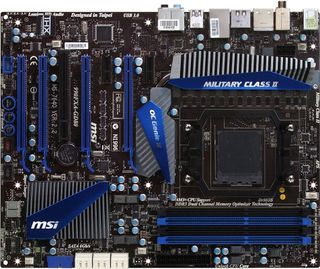Five $160 To $240 990FX-Based Socket AM3+ Motherboards
Forty-two PCIe lanes give the 990FX a clear connectivity lead over competing Intel chipsets. We compare five class-leading products using AMD's FX-8150 to see which offers the best combination of performance, overclocking, integrated features, and value.
MSI 990FXA-GD80
MSI’s three-way SLI and CrossFireX solution risks becoming an also-ran in a market topped by Gigabyte’s four-way alternative. MSI has a trick up its sleeve, though. Priced at only $180, the 990FXA-GD80 is the cheapest product to properly support three-way graphics modes. MSI gets there by automatically switching from x16-x0-x8 transfers to x16-x8-x8 whenever a card is installed in the middle slot, just like the more expensive offering from ECS.

Like ECS, MSI adds a CLR_CMOS button to its I/O panel. Unlike ECS, MSI chooses to conceal this button to reduce the incidence of accidental engagement. The 990FXA-GD80 also lacks ECS' second network port and Bluetooth transceiver, but the sacrifice of a few features was required to maintain this model's low price.
Layout aside, the most closely matched product in a combination of features and price comes from Asus. Yet, while the Sabertooth 990FX requires an eight-slot case to hold three double-slot cards in SLI or CrossFire, the 990FXA-GD80 can fit those same cards into a standard seven-slot case. The 990FXA-GD80 does lose the usefulness of its four-lane slot in this configuration, but the board also has a x1 slot at the top that’s completely missing from its Asus competition.

MSI slides its USB 3.0 header further south along the 990FXA-GD80’s front edge, but avoids collision with graphics cards by facing that connector forward. Case designers have long been making room for SATA cables in this area, so appropriate cases are plentiful.
Remaining layout concerns are trivial and apply to every model in this round-up, such as the bottom-rear corner front-panel audio connector and the close proximity between memory slots and the CPU socket. Both MSI and its competitors require extra-long front-panel cables, along with careful consideration of clearance between oversized CPU coolers and tall memory modules.

The 990FXA-GD80 includes three SLI bridges, the longer one designed to accommodate cross-connector placement for three-way SLI, along with the full set of six SATA cables and a USB 3.0 slot adapter plate.
Stay on the Cutting Edge
Join the experts who read Tom's Hardware for the inside track on enthusiast PC tech news — and have for over 25 years. We'll send breaking news and in-depth reviews of CPUs, GPUs, AI, maker hardware and more straight to your inbox.
-
timbo1130 How is this relevant to enthusiast? Bulldozer is out classed by Sandy Bridge I don't care if there are a few less sata ports. If you need to upgrade your better off going with Sandy bridge and z68 or p67 or wait for SB-E and X79.Reply -
julianbautista87 thanks for this article. I was waiting for it since some guy said that the 8150 was performing badly because of the mainboard used, but now I see that that was not correct.Reply -
_Pez_ Yeah If were to buy this boards would be with a Phenom real 6 core CPU 1100T :D that is the smartest choice. I think.Reply -
frostweaver I would wait till next year to decide. I still feel that windows 7 aint optimized for BD.Reply -
Tijok First off, thanks for the great article, good to see Tom's is keeping up the top notch quality!Reply
Secondly, I would really like to see a piece on extreme CFX/SLI configurations on rigs like this. It seems an article with reliable information on this would be beneficial to gaming enthusiasts, IT professionals, and HPC builders alike!
Hope to see an article along these lines soon! -
palladin9479 I bought the Sabertooth during the summer and I can attest to how amazing that board is. It's really nice, lots of features and high quality. I'm running a Phenom II X4 970BE @ 4.3Ghz on water right now. Absolutely wonderful system.Reply -
ta152h What a bunch of pretzel logic we have in this article.ReplyOf course, a fan of Intel's work could argue against the need for 42 lanes of second-gen PCIe when the 36 native to X58 Express support multi-card graphics configurations just as capably. But such a comparison really isn't necessary. After all, we've known for almost a year that Intel’s lower-cost Sandy Bridge-based part outperform the pricey six-core Gulftown-based processors in many desktop benchmarks, including pretty much every gaming scenario we throw at the two platforms.
So, x58 is irrelevant, because SB beats it. Except AMD's offering is somehow relevant even though both x58 and SB beat it. What?????
If you ignore x58 because SB offers better performance, you ignore anything AMD has because a SB setup offers better performance. If you want 36 or less lanes, x58 still offers better processors than you can hope to get from AMD. Bizarre logic.
Not that AMD is irrelevant, just the logic is badly flawed.
Most Popular


